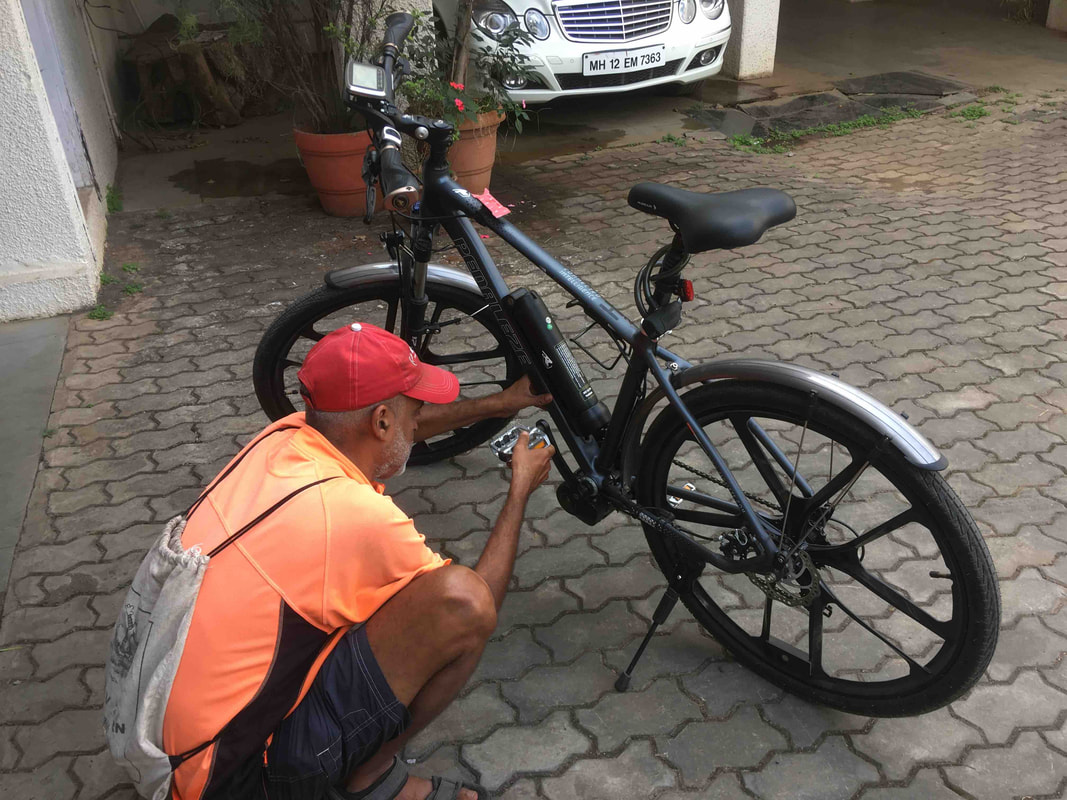|
Pedaleze is a Chennai based startup. What makes it different from other cycling startups is the active cycling background of the top management. And it shows in the product. Pleasing aesthetics. Good attention to details. A small bell that is integrated into the brake lever. The aluminium magnesium alloy wheels are a head turner. What I liked was a main battery driven tail lamp. This is important from a safety perspective. It comes on automatically when you switch on the headlamp. The below seat shock absorber is cute. It does give an easy ride. The patented hand grips have a rubber/plastic compound which gives a good grip. (I have found problems with these as they age - they can become sticky then.) The handle bar, with its adjustable hinge, helps a rider adjust to a more appropriate posture. The real test would be when I take it on a long ride.
The mid drive motor with torque sensor was a real pleasure to drive. There were some hiccups at the start. But I was instructed by Jay that when you switch on the motor, you need to ensure that the feet are off the pedal. That is because the first 5 seconds are taken to calibrate the zero weight for the torque sensor. In my first ride, I could not exceed 13 km per hour on an incline. But after I made the change in pedal pushing, I was going up the Symbiosis incline at close to 28 kmph. Having a crank motor helps synchronise the pedaling effort and the motor speed. A rear hub motor has that big disadvantage. Having experienced mid drive, hub motors look ancient now. The Bosch, Panasonic and Yamaha mid drives are not too great for two reasons. It involves a change in the frame. The other problem is weight. The motor design chosen by the Pedaleze team is much smaller. And it connects to a bigger ring gear, which is mounted on the pedal shaft. This ensures that you can use most standard frames. |
|
The cycle has a tendency to go into a kind of cruise control mode, even when the assist level is 0. You have to pedal harder constantly to maintain speed. This is because of the torque sensor. Actually cruise control is not possible, as thankfully there is no accelerator. But there is a walk mode, which can act as a pseudo cruise control - albeit at speeds of 3-4 kmph. I may be imagining this, but I felt that there are some dead spots on motor torque as you reach the top and bottom of your pedaling action. It could be because of an over-sensitive algorithm. Tinkering around to use average torque in the motor drive algorithm could help get those dead spots out. I spoke to Shiv, the founder who designed the cycle. He informed me that it is due to a 1.6 degree backlash in the gear train. A small amount of backlash has to be necessarily included for gear movement to happen. In the bike that I drove there were some issues with the bottom bracket, but I hope that it was something specific to that bike only.
The LCD display is fairly large and you have 3 modes - Eco, Tour, Speed and Turbo. I always wondered why would you need assist levels with a torque sensors. Having assist level in a cadence sensor based eBike makes sense. But in the case of the torque sensor, If the user wants to get less power - all they have to do is not exert force while pedaling. Jay said that, Assist levels are basically torque multipliers. So you get highest assist in Turbo mode and lowest in Eco Mode based on the effort applied on the pedal.
The bike is definitely value for money at Rs. 70,000. There is an app coming soon which will connect to your smartwatch and ensure that the pedal assist level changes to ensure a steady heart beat rate. This will be a good feature for senior citizen riders. (I think this will be a paid service though.) The light aluminum frame and mag alloy wheels help keep the weight on the right side of 20 kg. Though aluminium is not magnetic, this cycle can end up being a magnet for thieves!
You can reach the team at https://pedaleze.com






